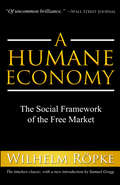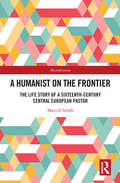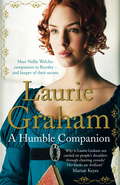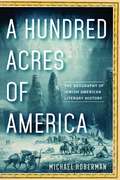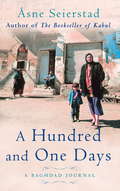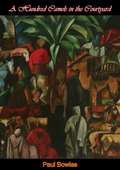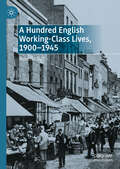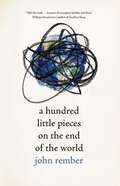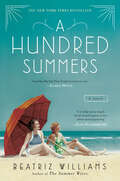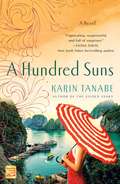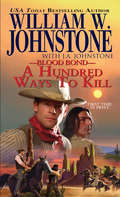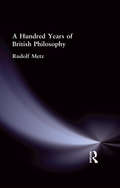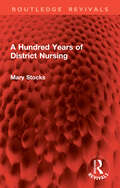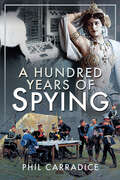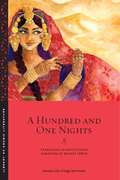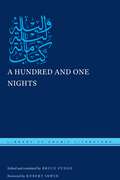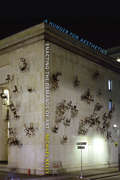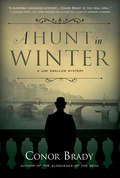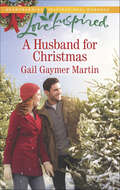- Table View
- List View
A Humane Economy: The Social Framework of the Free Market
by Wilhelm Röpke&“A Humane Economy is like a seminar on integral freedom conducted by a professor of uncommon brilliance.&” —Wall Street Journal&“If any person in our contemporary world is entitled to a hearing it is Wilhelm Röpke.&” —New York TimesA Humane Economy offers one of the most accessible and compelling explanations of how economies operate ever written. The masterwork of the great twentieth-century economist Wilhelm Röpke, this book presents a sweeping, brilliant exposition of market mechanics and moral philosophy.Röpke cuts through the jargon and statistics that make most economic writing so obscure and confusing. Over and over, the great Swiss economist stresses one simple point: you cannot separate economic principles from human behavior.Röpke&’s observations are as relevant today as when they were first set forth a half century ago. He clearly demonstrates how those societies that have embraced free-market principles have achieved phenomenal economic success—and how those that cling to theories of economic centralization endure stagnation and persistent poverty.A Humane Economy shows how economic processes and government policies influence our behavior and choices—to the betterment or detriment of life in those vital and highly fragile human structures we call communities. &“It is the precept of ethical and humane behavior, no less than of political wisdom,&” Röpke reminds us, &“to adapt economic policy to man, not man to economic policy.&”
A Humanist on the Frontier: The Life Story of a Sixteenth-Century Central European Pastor (Microhistories)
by Marcell SebőkA Humanist on the Frontier explores the remarkable life of Sebastian Ambrosius, a sixteenth-century Lutheran minister and intellectual from Késmárk (now Kežmarok) in present-day Slovakia, formerly on the borderland of the Kingdom of Hungary. Through an examination of Ambrosius’ publications and correspondence, this book throws new light on the dynamics of urban communities in Upper Hungary, communication within the humanist Republic of Letters in both Central European and wider European networks, and ecclesiastical controversies. Adopting methods of microhistory and cultural history, it also reconstructs Ambrosius’ life by positioning him in various contexts that trace his relationship to, and interpretations of, themes of power, tradition, vocation, communication and identity. This book is essential reading for scholars and students of early modern European history, as well as those interested in microhistory, cultural history, and the Republic of Letters.
A Humble Companion
by Laurie GrahamLoyalty tested to the limit. Dangerous secrets to keep. A lifelong friendship between a princess and a commoner. Nellie Welche's life changes for ever when she's proposed as companion to Princess Sophia, daughter of mad King George III and Queen Charlotte. Taken into the heart of the family, Nellie is privy to the innermost secrets of the rotten House of Hanover. From the first rumblings of the French Revolution to the beginnings of the railway age, Nellie charts their story as she and Sofy support each other through the ups and downs of their extraordinary lives.
A Humble Companion
by Laurie Graham&“A portrait of the riotous, tragicomic, dysfunctional, bonkers Royal family of poor George III. . . . Fascinating, very, very funny, ultimately humane.&” —Marian Keyes, international bestselling author When Nellie Welche is appointed companion to Princess Sophia, her family is delighted. It&’s more than her father, steward to the Prince of Wales, ever imagined for his daughter. But once Nellie begins spending her days in close quarters with the royal family, she discovers the world within the palace is not at all what she expected. Rather than attending royal balls and society events, Princess Sofy and her sisters live in isolation. There&’s also affable King George III, whose struggles with madness only deepen the privacy in which the royals must live. Over the course of a lifetime, Sofy and Nellie become inseparable. But as Sofy&’s dearest friend, Nellie is also the keeper of her secrets—until the scandal that threatens their relationship . . . and the reputation of the House of Hanover. &“Funny, fascinating and profoundly moving.&” —Freya North, international bestselling author of The Turning Point &“A delightfully smart and sophisticated historical novelist.&” —The Sunday Times &“Every page is a joy to read.&” —Daily Mail
A Humble Companion
by Laurie GrahamLoyalty tested to the limit. Dangerous secrets to keep. A lifelong friendship between a princess and a commoner. Nellie Welche's life changes for ever when she's proposed as companion to Princess Sophia, daughter of mad King George III and Queen Charlotte. Taken into the heart of the family, Nellie is privy to the innermost secrets of the rotten House of Hanover. From the first rumblings of the French Revolution to the beginnings of the railway age, Nellie charts their story as she and Sofy support each other through the ups and downs of their extraordinary lives.(P)2013 WF Howes Ltd
A Hundred Acres of America: The Geography of Jewish American Literary History
by Michael HobermanJewish writers have long had a sense of place in the United States, and interpretations of American geography have appeared in Jewish American literature from the colonial era forward. But troublingly, scholarship on Jewish American literary history often limits itself to an immigrant model, situating the Jewish American literary canon firmly and inescapably among the immigrant authors and early environments of the early twentieth century. In A Hundred Acres of America, Michael Hoberman combines literary history and geography to restore Jewish American writers to their roles as critical members of the American literary landscape from the 1850s to the present, and to argue that Jewish history, American literary history, and the inhabitation of American geography are, and always have been, contiguous entities.
A Hundred And One Days: A Baghdad Journal - from the bestselling author of The Bookseller of Kabul
by Asne SeierstadA fascinating, personal and insightful account of the Iraq war from the bestselling author of THE BOOKSELLER OF KABULIn January 2003 Åsne Seierstad entered Baghdad on a ten-day visa. She was to stay for over three months, reporting on the war and its aftermath. A Hundred and One Days is her compelling account of a city under siege, and a fascinating insight into the life of a foreign correspondent. An award-winning writer, Seierstad brilliantly details the frustrations and dangers journalists faced trying to uncover the truth behind the all-pervasive propaganda. She also offers a unique portrait of Baghdad and its people, trying to go about their daily business under the constant threat of attack. Seierstad's passionate and erudite book conveys both the drama and the tragedy of her one hundred and one days in a city at war.'Åsne Seierstad is the supreme non-fiction writer of her generation' Luke Harding
A Hundred And One Days: A Baghdad Journal - from the bestselling author of The Bookseller of Kabul
by x Asne SeierstadA fascinating, personal and insightful account of the Iraq war from the bestselling author of THE BOOKSELLER OF KABULIn January 2003 Åsne Seierstad entered Baghdad on a ten-day visa. She was to stay for over three months, reporting on the war and its aftermath. A Hundred and One Days is her compelling account of a city under siege, and a fascinating insight into the life of a foreign correspondent. An award-winning writer, Seierstad brilliantly details the frustrations and dangers journalists faced trying to uncover the truth behind the all-pervasive propaganda. She also offers a unique portrait of Baghdad and its people, trying to go about their daily business under the constant threat of attack. Seierstad's passionate and erudite book conveys both the drama and the tragedy of her one hundred and one days in a city at war.'Åsne Seierstad is the supreme non-fiction writer of her generation' Luke Harding
A Hundred Camels in the Courtyard
by Paul BowlesFirst published in 1962, A Hundred Camels in the Courtyard by American author Paul Bowles is a book comprising four tales of contemporary life in a land where cannabis, rather than alcohol, customarily provides a way out of the phenomenological world. Thus, of the men in these stories, Salam uses suggestions supplied by smoking kif to rid himself of a possible enemy. He of the Assembly catches himself up in the mesh of his own kif-dream and begins to act it out in reality. Idir’s victory over Lahcen is the classical story of the kif-smoker’s ability to outwit the drinker. Driss the soldier, with aid of kit, proves the existence of magic to his enlightened superior officer. For all of them the kif-pipe is the means to attaining a state of communication not only with others, but above all with themselves.“His work is art. At his best Paul Bowles has no peer.”—Time
A Hundred English Working-Class Lives, 1900-1945
by Rebecca BallStanley Rice, born in London in 1905, began his autobiography by stating that his life was ‘an ordinary average life with all its ups and downs’. Stanley may have described his life as ordinary, and yet he lived through a period of rapid social change, including two world wars. Despite this, Stanley assumed that his life story would be of little interest to most readers, as he had not achieved great fame or any notable accolades. This book argues that this is exactly why historians should focus on such life stories, as there is much to be gained by focusing on memories of ‘ordinary average lives’, as they can expand our knowledge of the past, often revealing firsthand experiences that have been excluded from the historical record. This book does not intend to be a general social history of the working class. Rather, it is a work of memory, drawing upon a microhistory methodology to examine how a sample of one hundred working-class autobiographers remembered and wrote about living through years that were punctuated by two worldwide conflicts and a global economic depression.
A Hundred Little Pieces on the End of the World
by John RemberWritten with clarity, tenacity, humor, and warmth, A Hundred Little Pieces on the End of the World attempts to find tolerable ethical positions in the face of barely tolerable events—and the real possibility of an intolerable future. It is a compelling, surprising, disturbing, and highly literate work of reportage and contemplation. It is both a collection of gentle-spirited wisdom and a rumination on ruin, as if distilled in equal measure from the spirits of Norman Maclean&’s A River Runs Through It and Cormac McCarthy&’s The Road.Through these ten essays, each further broken into ten smaller pieces, Rember examines the practical and ethical dilemmas of climate change, population, resource depletion, and mass extinction. At the same time, he never forgets those improbable connections between human beings that lead to moments of joy, empathy, and grace.
A Hundred Stories: Industrial Heritage Changes China
by Sunny Han Han Amal Zhuo LiThis book summarizes and classifies 100 wonderful Chinese industrial heritage cases, starting from the path of cultural tourism industry's involvement in the transformation and renewal of industrial heritage. With the development of industrialization for more than 100 years, China, which has been a major industrial heritage country, is often ignored in the field of industrial heritage research. This is the first book in the world to systematically explore the cultural and tourism industry's involvement in the transformation and renewal of Chinese industrial heritage. It fully contributed the wisdom and experience of the transformation of China's industrial heritage to the world, and provided important experience for the transformation of industrial heritage in other parts of the world. This book is not only a reference book for scholars, planners, and decision makers, but it will also inspire other readers who are concerned about China's urbanization and industrial heritage.
A Hundred Summers
by Beatriz WilliamsAs the 1938 hurricane approaches Rhode Island, another storm brews in this novel from the author of The Secret Life of Violet Grant. "Blends history, romance, and social commentary into...much more than a summer guilty pleasure" (Connecticut Post)Memorial Day, 1938Lily Dane has returned to Seaview, Rhode Island, where her family has summered for generations. It's an escape not only from New York's social scene but from a heartbreak that still haunts her. Here, among the seaside community that has embraced her since childhood, she finds comfort in the familiar rituals of summer.But this summer is different. Budgie and Nick Greenwald--Lily's former best friend and former fiancé--have arrived, too, and Seaview's elite are abuzz. Under Budgie's glamorous influence, Lily is seduced into a complicated web of renewed friendship and dangerous longing.As a cataclysmic hurricane churns north through the Atlantic, and uneasy secrets slowly reveal themselves, Lily and Nick must confront an emotional storm that will change their worlds forever...A PEOPLE STYLEWATCH MUST-READIncludes a Reader's Guide
A Hundred Suns: A Novel
by Karin TanabeNamed A Best Book of Spring 2020 by Real Simple · Parade · PopSugar · New York Post · Entertainment Weekly · Betches · CrimeReads · BookBub"A transporting historical novel, and a smart thriller."— Washington Post"A luscious setting combined with a sinister, sizzling plot." -EWA faraway land.A family’s dynasty.A trail of secrets that could shatter their glamorous lifestyle.On a humid afternoon in 1933, American Jessie Lesage steps off a boat from Paris and onto the shores of Vietnam. Accompanying her French husband Victor, an heir to the Michelin rubber fortune, she’s certain that their new life is full of promise, for while the rest of the world is sinking into economic depression, Indochine is gold for the Michelins. Jessie knows that the vast plantations near Saigon are the key to the family’s prosperity, and though they have recently been marred in scandal, she needs them to succeed for her husband’s sake—and to ensure that the life she left behind in America stays buried in the past. Jessie dives into the glamorous colonial world, where money is king and morals are brushed aside, and meets Marcelle de Fabry, a spellbinding expat with a wealthy Indochinese lover, the silk tycoon Khoi Nguyen. Descending on Jessie’s world like a hurricane, Marcelle proves to be an exuberant guide to colonial life. But hidden beneath her vivacious exterior is a fierce desire to put the colony back in the hands of its people––starting with the Michelin plantations.It doesn’t take long for the sun-drenched days and champagne-soaked nights to catch up with Jessie. With an increasingly fractured mind, her affection for Indochine falters. And as a fiery political struggle builds around her, Jessie begins to wonder what’s real in a friendship that she suspects may be nothing but a house of cards. Motivated by love, driven by ambition, and seeking self-preservation at all costs, Jessie and Marcelle each toe the line between friend and foe, ethics and excess. Cast against the stylish backdrop of 1920s Paris and 1930s Indochine, in a time and place defined by contrasts and convictions, Karin Tanabe's A Hundred Suns is historical fiction at its lush, suspenseful best.
A Hundred Ways to Kill: A Hundred Ways to Kill (Blood Bond #16)
by William W. Johnstone J.A. JohnstoneThese blood brothers are gunslingers with a conscience—and red-hot lead. Sharp-shooting adventure from the greatest Western writers of the 21st century. Young Matt Bodine and Sam Two Wolves became blood brothers on the day the rancher&’s son saved the warrior&’s life, forging a bond no one could ever break. And as years passed, a legend grew of the Cheyenne and the white man who rode together—and who could jerk killing iron with the best of them . . . A Hundred Ways to Kill Heading west to San Diego some honest pilgrims pay good money to keep their wagon train safe, but their guards soon turn against their charges and head off to Mexico with six young girls captive. When word reaches Tombstone—where Matt Bodine and Sam Two Wolves are wearing out their welcome gambling with Wyatt Earp—they know they have to do something about it. But it&’s going to take more than their bravery and shooting skills to rescue those girls from the merciless white slavers. On the way to Mexico, Matt and Sam ride into a war party of Apaches. They&’ll be facing outlaws and furious Apaches at the same time. For two blood brothers, the idea is to rescue those girls and blast their way North to freedom—no matter how many bullets it takes, or how many guns are shooting back . . . Praise for the novels of William W. Johnstone &“[A] rousing, two-fisted saga of the growing American frontier.&”—Publishers Weekly on Eyes of Eagles &“There&’s plenty of gunplay and fast-paced action.&”—Curled Up with a Good Book on Dead Before Sundown
A Hundred Years of British Philosophy
by Metz, RudolfFirst published in 2002. Routledge is an imprint of Taylor & Francis, an informa company.
A Hundred Years of District Nursing (Routledge Revivals)
by Mary StocksOriginally published in 1960, this is a graphic and humorous story of district nursing from its beginning, with the first nurse engaged to work in the slums of nineteenth-century Liverpool, up to the time of publication. Mrs Stocks records how ‘our nurse’ had been and still was a familiar and beloved figure in busy cities and remote rural areas throughout the United Kingdom and was rapidly assuming a similar position in many other parts of the world.William Rathbone of Liverpool early recognized the need for a central organization to recruit and train district nurses and became the father of the Queen Victoria Jubilee Institute for Nurses, or as it became, the Queen’s Institute of District Nursing (now Queen’s Institute of Nursing). The background of its formation gives a fascinating glimpse of different classes of Victorian England. Mrs Stocks describes how Queen Victoria, the Institute’s first Patron, conveyed her wishes to the ‘top people’ who devised and organized the service with the inflexible guidance of Florence Nightingale. At the other end of the scale, she tells of some of the appalling conditions found in the homes by the pioneer nurses. She describes how the Queen’s Institute grew from strength to strength in spite of buffeting by high political winds, until at the time it played an important part in preserving the nation’s health. Today it is a registered charity dedicated to improving the nursing care of people in the home and community.
A Hundred Years of Spying
by Phil CarradiceEarly espionage organisations like Walsingham’s Elizabethan spy network were private enterprises, tasked with keeping the Tudor Queen and her government safe. Formal use of spies and counter spies only really began in the years after 1909, when the official British secret service was founded. Britain became the first major proponent of secret information gathering and other nations quickly followed. The outbreak of war in 1914 saw a sudden and dramatic increase in the use of spies as the military quickly began to realise the value of covert intelligence. Spying ‘came of age’ during the war on the Western Front and that value only increased in the run up to the Second World War, when the threat of the Soviet Union and Nazi Germany began to make themselves felt. The Cold War years, with the use of moles, defectors and double agents on both sides of the Iron Curtain saw the art of spying assume record proportions. The passing on of atom secrets, the truth about Russian missiles on Cuba, it was the age of the double agent, the activities of whom managed to keep away the looming threat of nuclear war. A Hundred Years of Spying takes the reader through the murky world of espionage as it develops over the course of the twentieth century, where the lines of truth and reality blur, and where many real-life spies have always been accompanied, maybe even proceeded, by a plethora of spy literature. This book will look at the use of and development of spying as an accepted military practice. It will focus on individuals from Belgians like Gabrielle Petite to the infamous Mata Hari, from people like Reilly Ace of Spies to the British traitors such as Philby, Burgess and McClean. The activities of American atom spies like the Rosenbergs will also be covered as will Russian double agent Oleg Penkovsky and many others.
A Hundred and One Nights (Library of Arabic Literature #10)
by Bruce FudgeFantastic tales of magic and wonderTranslated into English for the very first time, A Hundred and One Nights is a marvelous example of the rich tradition of popular Arabic storytelling. Like the celebrated Thousand and One Nights, this collection opens with the frame story of Scheherazade, the vizier’s gifted daughter who recounts imaginative tales night after night in an effort to distract the murderous king from taking her life. A Hundred and One Nights features an almost entirely different set of stories, however, each one more thrilling, amusing, and disturbing than the last. Here, we encounter tales of epic warriors, buried treasure, disappearing brides, cannibal demon-women, fatal shipwrecks, and clever ruses, where human strength and ingenuity play out against a backdrop of inexorable, inscrutable fate. Distinctly rooted in Arabic literary culture and the Islamic tradition, these tales draw on motifs and story elements that circulated across cultures, including Indian and Chinese antecedents, and features a frame story possibly older than its more famous sibling. This vibrant translation of A Hundred and One Nights promises to transport readers, new and veteran alike, into its fantastical realms of magic and wonder.An English-only edition.
A Hundred and One Nights (Library of Arabic Literature #45)
by Bruce FudgeFantastic tales of magic and wonderEdited and translated into English for the first time, A Hundred and One Nights is a marvelous example of the rich tradition of popular Arabic storytelling. Like its more famous sibling, the Thousand and One Nights, this collection opens with the frame story of Shahrazad, the gifted vizier’s daughter who recounts imaginative tales night after night in an effort to distract the murderous king from taking her life. A Hundred and One Nights features an almost entirely different set of stories, however, each one more thrilling, amusing, and disturbing than the last. In them, we encounter tales of epic warriors, buried treasures, disappearing brides, cannibal demon women, fatal shipwrecks, and clever ruses, where human strength and ingenuity play out against a backdrop of inexorable, inscrutable fate.Although these tales draw on motifs and story elements that circulated across cultures, A Hundred and One Nights is distinctly rooted in Arabic literary culture and the Islamic tradition. It is also likely much older than Thousand and One Nights, drawing on Indian and Chinese antecedents. This careful edition and vibrant translation of A Hundred and One Nights promises to transport readers, new and veteran alike, into its fantastical realms of magic and wonder.A bilingual Arabic-English edition.
A Hunger for Aesthetics: Enacting the Demands of Art (Columbia Themes in Philosophy, Social Criticism, and the Arts)
by Michael KellyFor decades, aesthetics has been subjected to a variety of critiques, often concerning its treatment of beauty or the autonomy of art. Collectively, these complaints have generated an anti-aesthetic stance prevalent in the contemporary art world. Yet if we examine the motivations for these critiques, Michael Kelly argues, we find theorists and artists hungering for a new kind of aesthetics, one better calibrated to contemporary art and its moral and political demands.Following an analysis of the work of Stanley Cavell, Arthur Danto, Umberto Eco, Susan Sontag, and other philosophers of the 1960s who made aesthetics more responsive to contemporary art, Kelly considers Sontag's aesthetics in greater detail. In On Photography (1977), she argues that a photograph of a person who is suffering only aestheticizes the suffering for the viewer's pleasure, yet she insists in Regarding the Pain of Others (2003) that such a photograph can have a sustainable moral-political effect precisely because of its aesthetics. Kelly considers this dramatic change to be symptomatic of a cultural shift in our understanding of aesthetics, ethics, and politics. He discusses these issues in connection with Gerhard Richter's and Doris Salcedo's art, chosen because it is often identified with the anti-aesthetic, even though it is clearly aesthetic. Focusing first on Richter's Baader-Meinhof series, Kelly concludes with Salcedo's enactments of suffering caused by social injustice. Throughout A Hunger for Aesthetics, he reveals the place of critique in contemporary art, which, if we understand aesthetics as critique, confirms that it is integral to art. Meeting the demand for aesthetics voiced by many who participate in art, Kelly advocates for a critical aesthetics that confirms the power of art.
A Hunger for Learning: A Story about Booker T. Washington
by Gwenyth SwainAs a small child, Booker T. Washington longed to learn how to read and write, but slaves weren't allowed to go to school. When the Civil War ended, Booker was free. He persuaded teachers at the Hampton Institute to let him work at their school in exchange for classes. Booker did so well that Hampton's principal recommended him to start up a new school in Alabama. Brick by brick, Washington and his students built Tuskegee Institute, which became one of the nation's most respected colleges for black students. Dedicating his life to education, Booker T. Washington was one of the most important African American leaders of his time.
A Hunt in Winter: A Joe Swallow Mystery (A Joe Swallow Mystery)
by Conor BradyIn Dublin, newly promoted detective inspector Joe Swallow’s life looks to be taking a turn for the better. In addition to his promotion, he’s settled into a comfortable arrangement with his landlady and paramour, Maria Walsh. That is, until his newfound peace is chaotically uprooted when a series of violent attacks against women lead to an outbreak of panic and fear. Things on the homefront are about to change in an unexpected way.In London, Charles Stewart Parnell tirelessly pursues the Irish cause for Home Rule. While the British are eager to discredit the Irish parliamentary leader and quash the growing movement towards independence, Swallow’s conflicted loyalties pull him in different directions.As he continues his hunt for a terrifying killer, Swallow has no choice but to traverse this volatile political scene in A Hunt in Winter, Conor Brady’s thrilling third Joe Swallow mystery.
A Husband To Hold (Hill Creek, Texas)
by Cheryl WolvertonRUNNING AWAYShe had caught everyone’s eye. Petite, mysterious Leah Thomas was new to Hill Creek, Texas, and the entire town had taken notice. Especially one handsome cowboy, who’d offered to give Leah some much-needed help.Soon Mark Walker learned that the blond beauty wasn’t as helpless as she appeared. But she had something hidden inside that she refused to reveal. And Mark was determined to find the key to her heart....Leah was running from a past she couldn’t forget. But to help her, Mark had to stop running, too. Only with God’s help-and each other’s-could they reach their paths of redemption and find a future together....
A Husband for Christmas
by Gail Gaymer MartinThe Bachelor Next DoorSpending her holidays in picturesque Lilac Circle, Michigan, is the perfect place for Nina Jerome to start anew. She’s determined to put her painful divorce in the past and focus on the future. She hadn’t planned on being distracted by her sweet neighbor, Doug Billings. The successful businessman and temporary dad is clueless when it comes to taking care of his little niece. Getting help from Nina is the perfect setup—but something about the pretty new nanny makes him think about the unthinkable: having a wife and a family of his own. Can he convince Nina that she’s worthy of a second chance at love—just in time for Christmas?
